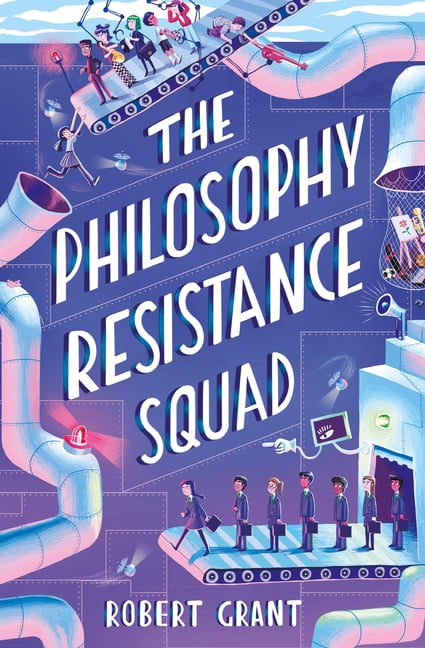Thought Control? – Aha, Foiled Again!
Here are two books I would love to see taught in all middle schools but especially Catholic ones.
Both (almost) made me want to start teaching again – even in middle school!

One is called Attack of the Black Rectangles by Amy Sarig King. The menacing “black rectangles” of the title attack pre-teen’s schoolbooks, first encapsulating and then issuing weapons of black ink to blot out certain words those in “authority” have deemed too incendiary, too provocative, too corrupting for the repressive town’s young minds in the process of being oh so carefully molded – for their own protection, of course. (“We don’t have Halloween, anymore, or junk food. We don’t have bad thoughts. We don’t use any bad words, like cancer or death or sex or doughnut,” one character says.)
In the story, two of these school children are curious why certain words and not others have been blackened out in a classroom-assigned and prize-winning book about a young American girl’s experiencing the horror of the Holocaust. Puzzled by the censorship of something they have been told to read, they find an original copy of the story and discover one commonly redacted word is “breast”. They are mystified. The boy points out they all know what they are, and the girl adds she is ‘old enough to have actual breasts, so I don’t understand the problem.” But I’ll bet we do, especially we who grew up as Catholic girls, covering our heads in Church, eschewing patent leather shoes, sitting separately from the boys. We know those black rectangles; they often covered our mouths, smothered our thoughts, and helped make us invisible.

The second book is The Philosophy Resistance Squad by Robert Grant. Set in Grant’s native country, Ireland, the story centers around a boy “fortunate” enough to have been accepted to “the most famous, the most highly ranked, and the wealthiest school in all of Ireland.” To succeed, all he needs to do is be diligent in his studies and, more importantly, practice unwavering obedience to all in authority and to their rules. The school’s acronym is, most appropriately: STIFLE! Its goal: to give the economy and society the kind of docile, submissive, unquestioning, and staunchly disciplined workforce they most desire.
Of course, this is a book directed at middle school-age students, and so there’s lots of fun things that do the actual stifling: the roaming, robot-like proctors (Disciplods), the school chairs that “clench and close tight” when students sit in them restricting all restless or furtive movements,
and the futuristic technology Du-Ped (Digitally Unique Personalized Education Database) that
pinches and even shocks students talking out of turn or even raising their hands to ask for the
bathroom. As the teacher points out: “Toilet breaks and everything else is governed by Du-Ped.
It knows when you have to go.” Reading how the main character first suffers and then
maneuvers around these systems adds to the fun. An exaggeration of past Catholic classrooms –
or even pews – run kind of the same but without the high tech help? Yes…and no.
The reprieve from all this stifling comes when the character, seeking escape from the discipliners
and their suppression, stumbles upon a hidden garden on the grounds tended by a former philosophy teacher. As days progress, she leads him and a few friends into more philosophical musings and discussions: “Are we free to do as we want? Is wisdom the same as knowledge?” As the garden flourishes, their deadened minds do, too. And as they come fully alive again, the children form the Philosophy Resistance Squad and the tension grows from there: Will the philosophy teacher’s way of educating and the natural setting itself give them the resources they need to resist surrendering to STIFLE, to defeat its evils, and propel them toward a better future? As NYT reviewer, Jennifer Howard, puts it:
“If an obsession with results shuts children down,
Grant suggests, philosophy can set them free again.”
The philosophy they learn mostly encourages them to keep asking “Why?” It spurs them on to
challenge censorship, manipulation, bullying, and the tyranny of authorities and the systems they
create to implant in children only what they have determined is best for them. But the promise is
by keeping on asking “why” and never accepting “because I said so” as an answer they just may
triumph in the end.
I suspect you have learned all the above lessons already or you would not be keeping up our mission for the rights of all genders to question authority, defy unjust “tradition” (especially when the justification for its predominance is “because we told you so”), challenge the Church’s own “results obsession,” i.e., its preservation of its most repressive doctrines in an ill-conceived attempt to preserve itself – at the expense of the richly diverse people who would like to serve and enrich it and be served and be enriched in return.
Fortunately, thanks to all we have learned in our long struggle, we do keep on demanding answers to all our “Why?” questions as well as demanding the right to keep asking them. Let’s help our children do the same, and I think these two books do just might do that – while offering some lively fun along the way. Hmmm. Maybe we – who could use a bit of light refreshment in this lengthy task – have something to learn, too. Putting more wit in our witness, cheer in our challenge, verve in our service could spur us on as well!

One Response
CANON 1024 + ORDINATIO SACERDOTALIS = STIFLE